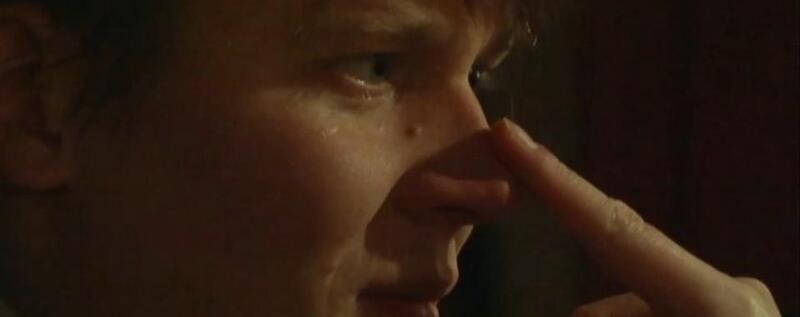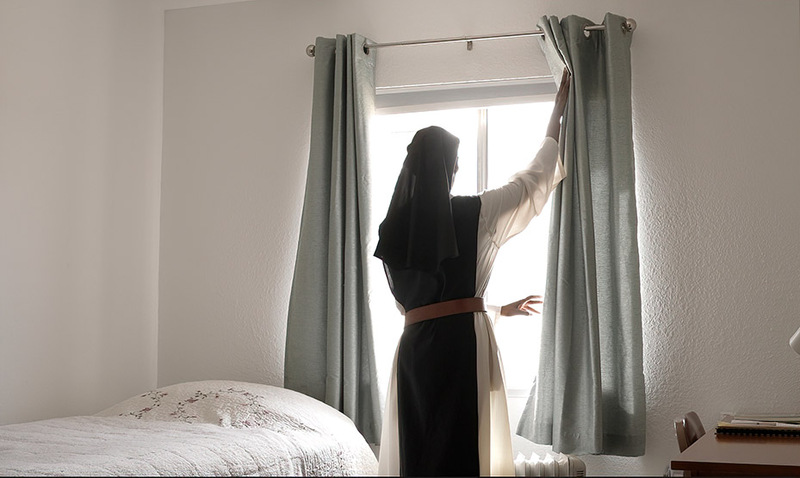
It’s Weird, Quiet, and Kind of Perfectly Off
MOVIE REVIEW
The Sphinx
–
Genre: Dark Comedy
Year Released: 2025
Runtime: 16m
Director(s): Jesse Padveen
Writer(s): Jesse Padveen
Cast: Solly Mac, Vanessa Egan, Tom Lute, Patricia Harris, Harold Tausch
Where to Watch: Shown at the 2025 Slamdance Film Festival
RAVING REVIEW: Sometimes, it takes a cold night, a broken lock, and a pricey locksmith bill to inspire a film that makes you feel trapped in a haunted memory. That’s the unlikely spark behind THE SPHINX, a lo-fi psychological short that leans hard into discomfort and disconnection. What starts grounded in real-life frustration slowly shifts into something more unsettling, less about plot mechanics and more about the surreal weight of feeling disconnected from your reality.
No big setup, sweeping camera shots, or heightened production bells and whistles exist. This is bare-bones storytelling told through a lens that feels pulled from a dusty VHS drawer. The choice to shoot on MiniDV wasn’t just a budget call—it’s a decision that defines the whole experience. The analog quality gives everything a kind of warped nostalgia. The aesthetic is so raw that it almost feels like you’re watching something you weren’t supposed to see.
Rather than fighting its limitations, THE SPHINX embraces them like a creative badge. A single light sets the visual tone, and it’s amazing how much that simplicity works in the film’s favor. The stripped-down tone adds an almost objective-style intimacy, making the uneasy atmosphere more effective. Everything feels close—claustrophobic even. But it never feels cheap. It feels intentional.
The story itself doesn’t unfold how you expect. There's no clear beginning, middle, or resolution. The structure is closer to a fragmented memory—a series of hazy moments where time bends and meaning drifts. You’re left piecing things together not from dialogue or exposition but from suggestion, tone, and silence. The film trusts you to engage without holding your hand, which can be challenging but rewarding if you’re in the right headspace.
One of the film’s strongest tools is how it uses silence. Dialogue is minimal and purposeful, often giving way to long pauses or ambient noise that fills the space better than words could. It’s a smart stylistic choice that dials into the protagonist’s internal spiral. You’re not always seeing his thoughts, but you’re feeling them—through sounds, lighting, and the eerie stillness that lingers just a second too long.
One of the more notable achievements here is how discomfort is treated not as a problem to solve but as a mood to inhabit. The director gives awkwardness the space to breathe. There’s no rush to explain what’s going on or resolve it. Instead, you sit with it. The unease grows not from what's happening on screen but from what’s not—and that takes nerve. It also requires confidence in the audience to stay with the story even when it doesn’t offer easy guideposts.
THE SPHINX doesn’t aim for traditional emotional payoffs. It floats in that murky space between waking and dreaming, where nothing resolves and everything lingers. This dream-logic structure suits its themes but might alienate viewers looking for a more grounded or structured narrative. Still, for those willing to let go of conventional expectations, there’s a lot to appreciate in how the film commits to its tone.
What makes this story even more compelling is the context of its creation. The director spun a series of real-life frustrations—getting dumped, walking through a storm, and being locked out of his home—into something oddly poetic. That blend of humor, irritation, and isolation becomes the emotional palette for the entire project.
Every decision was made to evoke a specific emotion rather than build toward a plot twist or climactic moment. That restraint is refreshing, especially when many stories chase the big spectacle. This one lingers in its strange energy. It captures the emotional static from personal chaos—where nothing feels right and everything feels slightly off-center. It’s rough around the edges, but it’s also honest about where it came from and what it’s trying to say.
What makes it stand out isn’t polish or precision but a consistent commitment to tone and texture. That commitment makes the rough patches feel less like mistakes and more like scars. If you're looking for a genre piece that’s unconventional but grounded in genuine emotion, this is worth sitting with. Don’t expect it to guide you—this one prefers you get lost.
Please visit https://linktr.ee/overlyhonestr for more reviews.
You can follow me on Letterboxd, Instagram, Twitter, and YouTube. My social media accounts can also be found on most platforms by searching Overly Honest Reviews.
I’m always happy to hear from my readers; please say hi or send me any questions about movies.
DISCLAIMER:
At Overly Honest Movie Reviews, we value honesty and transparency. Occasionally, we receive free items for review, including DVDs, Blu-rays, CDs, Vinyl, Books, etc. We assure you that these arrangements do not influence our reviews, as we are committed to providing unbiased and sincere evaluations. We aim to help you make informed entertainment choices regardless of our relationship with distributors or producers.
Amazon Affiliate Links:
Additionally, this site contains Amazon affiliate links. If you purchase through these links, we may receive a commission. This affiliate arrangement does not affect our commitment to honest reviews and helps support our site. We appreciate your trust and support in navigating these links.



Average Rating